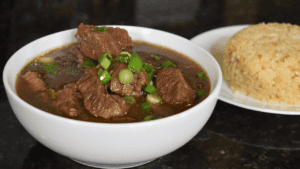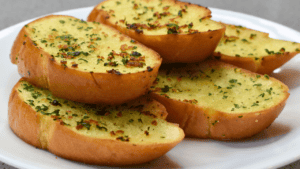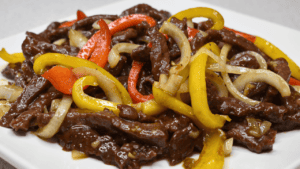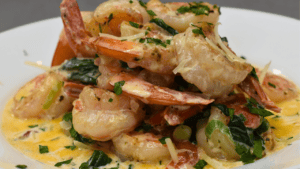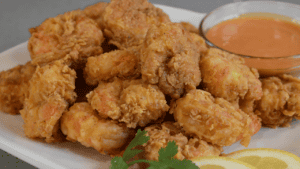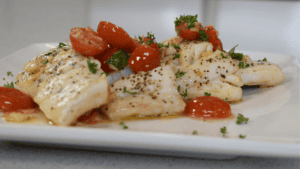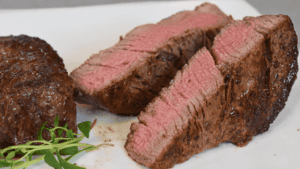Escabeche
Escabeche is a popular Filipino dish that consists of fried fish or meat, topped with a sweet and sour sauce made from vinegar, soy sauce, sugar, and various spices. This dish has Spanish origins and the name “escabeche” comes from the Spanish word “escabechar”, which means to marinate in an acidic solution.
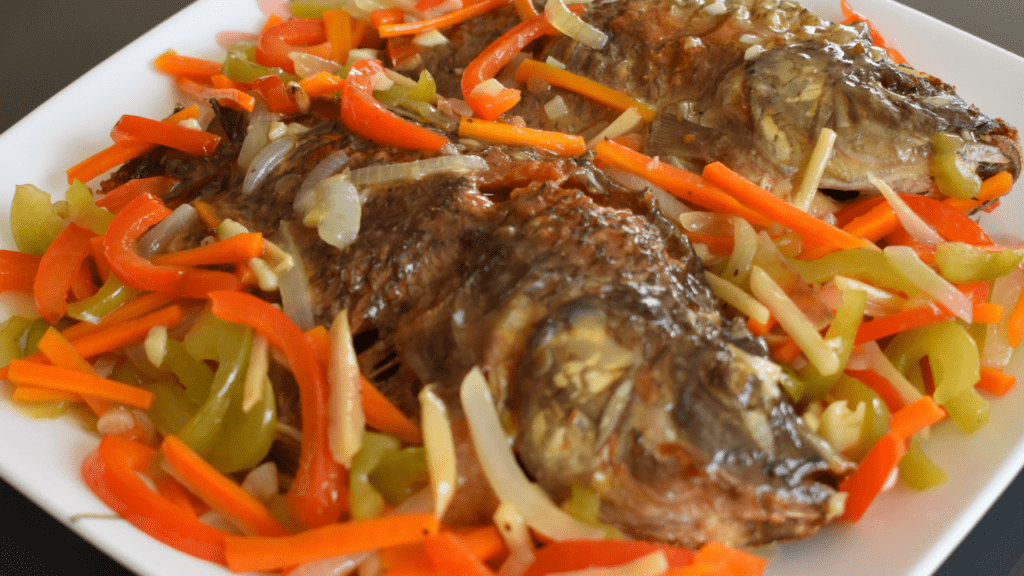
How to Cook Escabeche: A Delicious Filipino Dish
Filipino cuisine is a melting pot of flavors, and one dish that captures the essence of sweet, sour, and rich umami that pampers your taste buds is Escabeche. This beloved Filipino dish is as vibrant as it is delicious, and it’s a must-try for anyone looking to explore the culinary wonders of the Philippines. Whether you’re a home cook eager to expand your repertoire, or simply a food enthusiast yearning to taste the world from your kitchen, let’s dive into what it takes to cook up the perfect Escabeche.
Ingredients
Before you master the art of cooking Escabeche, you must first gather all the essential ingredients. Here’s what you need:
- 2 whole fish (tilapia, mackerel, or snapper work well)
- 2 tbsp cooking oil
- 1 small onion, chopped
- 4 cloves garlic, minced
- 1 small piece of ginger, sliced into strips
- 1 small carrot, cut into matchsticks
- 1 small green bell pepper, sliced
- 1 small red bell pepper, sliced
- 3 tbsp sugar
- 3 tbsp vinegar
- 1 tbsp cornstarch
- 1 cup water
This list ensures you have everything to create the perfect blend of sweet, savory, and tangy flavors that define Escabeche.
Preparation
Preparing for the cooking process is as crucial as the cooking itself. Follow these steps to get the fish or meat ready:
- Clean and gut the whole fish, and make a couple of slits on each side to help the flavors penetrate.
- Pat the fish or meat dry with paper towels to ensure a crispy fry later on.
- Season the fish with salt and pepper. Optionally, you can marinate the fish in soy sauce, garlic, and ginger for an hour to infuse with extra flavor and tenderize the meat.
- If using fish, lightly coat it in cornstarch to help achieve a crispy texture when frying.
Preparation not only enhances the taste but also sets the stage for the visual appeal of the final dish.
Cooking Method
The key to perfect Escabeche is the process. Here’s what you need to do:
- In a deep pan, heat oil over medium-high heat until hot.
- Gently lay your fish in the pan and fry until golden brown on both sides. If you’re using a thicker cut of fish, consider lowering the heat and partially covering the pan to ensure the inside is fully cooked.
- If you’re cooking meat, brown it in the pan, then set it aside to be added back into the dish later for a shorter cooking time.
- To achieve that ideal crispiness, fry the fish or meat in batches if necessary, making sure not to overcrowd the pan.
Frying your protein just right will make all the difference, creating a texture that stands up to the rich sauce yet still maintains a tender interior.
Sweet and Sour Sauce
The heart of Escabeche is its sweet and sour sauce. It’s about achieving a perfect balance of flavors. Here’s how:
- Saute the onion, garlic, and ginger until aromatic in the same pan you fried the fish.
- Add the carrots and bell peppers, cooking until they just start to soften.
- Pour in the vinegar and sugar. This is where the magic of Escabeche begins. Vinegar provides the tang and sugar brings the sweetness.
- In a separate bowl, combine cornstarch with water to make a slurry and pour it into the pan to thicken the sauce.
The sweet and sour sauce should have a syrupy consistency, coating the back of a spoon. It’s this luscious texture that will cling to your fish or meat, accentuating its flavor.
Serving and Presentation
Escabeche isn’t just about taste—it’s an experience for all the senses. Here’s how to enhance the delight of your dish:
- Garnish with green onions to add a pop of color and additional flavor.
- Serve with a side of steamed rice, the perfect canvas to soak up all the saucy goodness.
- Experiment with different textures by including a crispy side of prawn crackers or crunchy pickled vegetables.
The joy of cooking and serving Escabeche is in the details. Pay attention to every element to create a meal that is as pleasing to the eye as it is to the palate.
Conclusion
Escabeche is a dish that embodies the spirit of Filipino cuisine—complex, yet comforting; sweet, yet bold. It’s a feast for the senses that invites you to discover the delightful taste of the Philippines. With a bit of care and a dash of adventure, anyone can master the art of cooking Escabeche. So why not take a step into the vibrant world of Filipino flavors and treat yourself and your loved ones to this beloved dish?
Whether you’re celebrating a special occasion or spicing up a regular weeknight dinner, Escabeche is a surefire way to add a unique and delectable dish to your table. Don’t shy away from the boldness of its flavor; embrace it and make it your own. Let the aroma of the sweet and sour sauce fill your kitchen, as you create a meal that not only nourishes but also delights. It’s time to pick up your apron, gather your ingredients, and savor the journey of cooking Escabeche.
Frequently Asked Questions
What is escabeche sauce made of?
Escabeche sauce is a type of vinegar-based marinade commonly used in Spanish and Latin American cuisine. It is typically made with a combination of vinegar, olive oil, herbs and spices such as bay leaves, peppercorns, oregano, and garlic.
What does escabeche mean in cooking?
In cooking terms, escabeche refers to a cooking technique where food (often fish or poultry) is first fried or sautéed in oil then marinated in the vinegar mixture. This method helps preserve the food while also infusing it with flavor.
Is escabeche raw?
Escabeche can be served hot or cold depending on personal preference. Some may consider it “raw” as the marinade does not involve any heating or cooking process.
Is escabeche the same as ceviche?
Although escabeche and ceviche both involve marinating seafood in acidic liquid (usually citrus juice), they are not the same dish. Ceviche uses raw seafood while escabeche involves frying or sautéing before marinating.
How do you say escabeche in English?
In English, escabeche is pronounced as “es-kuh-bech”.
What is the meaning of escabeche?
Escabeche is a Spanish word that refers to a dish of marinated and fried fish or meat, typically served cold as an appetizer or side dish. The term originated from the Arabic word “sikbaj,” which referred to pickling food in vinegar. This method of preserving and flavoring food was brought to Spain during the Moorish occupation and eventually spread throughout many Latin American and Caribbean countries.
Where did escabeche come from?
The word “escabeche” originated from Arabic through its Spanish usage. The term was originally used for pickled vegetables but evolved to include meat and fish dishes that use similar methods of preservation.
What is the difference between Escovitch and escabeche?
There are some slight differences between Escovitch (a Jamaican dish) and traditional escabeche: Escovitch often incorporates more spicy peppers than traditional Spanish/Latin American recipes. Additionally, Escovitch usually includes onions that are cooked directly into the sauce rather than just being added as a topping like in traditional escabeche dishes.
Do you eat escabeche cold?
Escabeche can be eaten cold or at room temperature after it has been marinated for several hours to allow flavors to develop fully. It is commonly served with rice dishes or as an appetizer alongside other tapas-style foods.
Who invented escabeche?
It’s difficult to pinpoint who officially invented escabeche. However, it is believed to have originated in Spain and then spread throughout Latin America and the Caribbean due to Spanish colonization.
Today, escabeche can be found in many variations depending on the region and cultural influences. For example, Filipino escabeche uses a sweet and sour sauce with added sugar and carrots while Peruvian escabeche includes seafood like octopus and squid.
Some popular dishes that incorporate escabeche sauce include pickled fish, sardines in vinegar, and chicken escabeche. It is a versatile sauce that can elevate the flavor of many different ingredients and add a tangy punch to any dish.
More Filipino Recipes
Embark on a culinary adventure and experience the rich flavors of the Philippines with our handpicked selection of recipes. Delve into the world of Filipino cuisine, where every dish tells a story of heritage and tradition.
- Chicken Adobo. This beloved dish marries the tanginess of vinegar with the deep, warming notes of soy sauce, all infused with a fragrant harmony of garlic and bay leaves.
- Menudo. A festive stew that’s often the star at family gatherings and special occasions. The rich tomato base simmers along with tender pork, liver, carrots, and potatoes, creating a medley of flavors and textures that are both delightful and filling.
- Beef Tapa. A must-try. This savory, garlicky cured beef is typically enjoyed as part of a ‘silog’ meal—paired with fried rice (sinangag) and a sunny-side-up egg (itlog). It’s the breakfast of champions and a tasty energy booster to start your day.
- Pork Sinigang. This sour soup features pork ribs or belly, tamarind, and a variety of vegetables like radishes, green beans, and water spinach. Each spoonful delivers a burst of sourness that will make your palate dance, perfect for reinvigorating your senses.
- Sarciadong Tilapia. This dish showcases plump, pan-fried tilapia topped with a savory-sweet tomato and egg sauciness that’ll leave you craving more. Its straightforward preparation highlights the tilapia’s freshness while providing a delightful contrast of flavors.
Join us on this flavorful journey by trying your hand at these Filipino classics. Each recipe promises to transport you to the bustling streets and tranquil provinces of the Philippines, where food is lovingly prepared, shared, and cherished. Happy cooking!
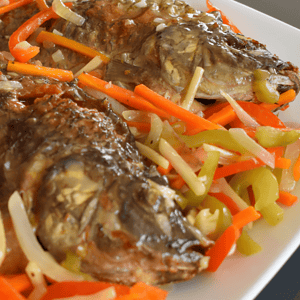
Escabeche
Ingredients
- 2 whole fish tilapia
- 2 tbsp cooking oil
- 1 small onion chopped
- 4 cloves garlic minced
- 1 small ginger sliced
- 1 small carrot cut into strips
- 1 small green bell pepper chopped
- 1 small red bell pepper chopped
- 3 tbsp sugar
- 3 tbsp vinegar
- 1 tbsp cornstarch
- 1 cup water
Instructions
- Fry the fish until golden brown on each side. Set aside.
- In a saucepan over medium heat, sauté onion, garlic, and ginger in cooking oil.
- Add carrots, green and red bell peppers to the saucepan.
- Pour vinegar and sugar into the mixture.
- Stir in cornstarch and water, stirring occasionally.
- Season with salt and pepper, and cook until the sauce thickens.
- Pour the sauce over the fried fish.
